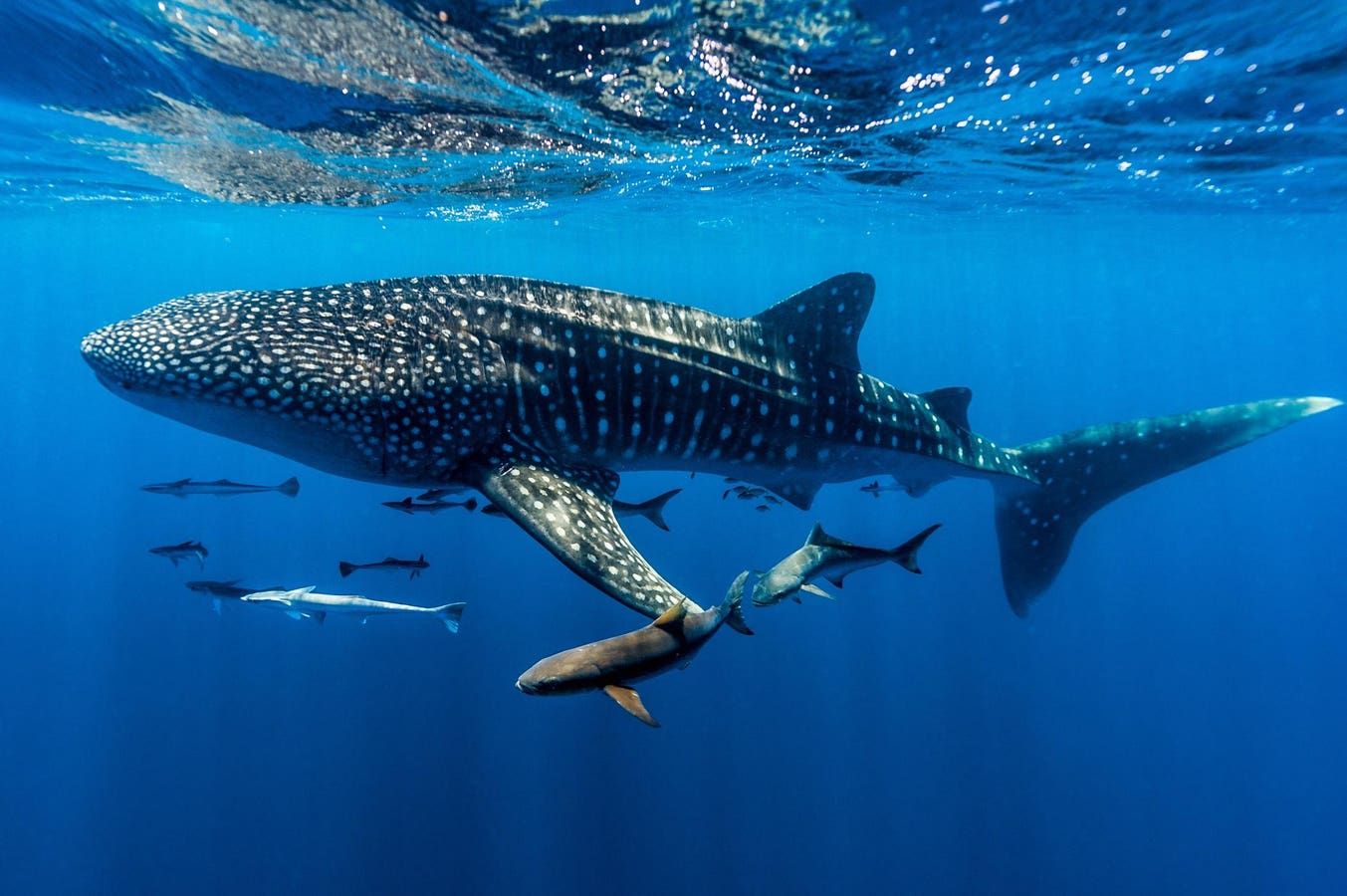Conservation of whale sharks is fraught with challenges, including targeted hunting, accidental … More
In 2011, the Gujarat Forest Department, together with the Wildlife Trust of India, began to track whale sharks using satellite telemetry. Their first success came when a 21 foot (6.5 meter) long male whale shark, accidentally caught in a trawl net near Sutrapada, was tagged and released. That shark swam more than 125 miles (200 kilometers) before its transmitter went silent off Maharashtra’s coast. Since then, the team has tagged 11 whale sharks, slowly unlocking the mysteries of how these ocean giants move through Indian waters. The most recent tag, placed on December 22, 2024, has already recorded over 100 days of data and a migration spanning more than 2,485 miles (4,000 kilometers).
The latest tagged whale shark was a healthy adult male measuring about 28 feet (8.5 meters) long and weighing nearly seven metric tonnes. As soon as fishermen reported the shark’s entanglement, a rescue team, including a forest officer, veterinarian and WTI staff, raced 3.6 nautical miles into the sea on an outboard motorized fiber boat. Whale shark tagging, afterall, is a race against time. Because these massive fish easily exhaust themselves trying to breathe through tangled nets, any delays can be fatal. “We certainly cannot delay the release as it adds to the stress on the fish,” explained Farukhkha Husenkha, WTI’s project lead. But tagging whale sharks is no easy task. The SPOT tags must be carefully drilled into the dorsal fins, ideally from small Outboard Motor Boats boats close to the water surface. Rough seas and the unavailability of boats make operations tricky. With declining fish catches and the use of larger gillnets, OBM operators are sometimes unwilling to venture into the high seas. Trawl boats are an alternative but increase risks for both the animal and rescuers.
WTI’s Whale Shark Conservation Project started in 2008 in response to a grim history for whale sharks. Before 2000, these massive predators were hunted heavily for their fins and liver oil. Over 600 were landed in 1999-2000 alone around Veraval and neighboring coasts. But thanks to years of advocacy, public support and policy changes, whale sharks were finally protected under India’s Wildlife (Protection) Act, 1972. Gujarat’s fishermen became key allies to make this happen, encouraged by a government scheme that compensates them for damaged nets if they release an entangled whale shark. Since then, local fishers have released 979 whale sharks!
The project has not only saved adults but also rescued at least 17 neonate whale sharks. “Going by the numbers, Gujarat seems to have the highest aggregation of the world’s largest fish along the Indian coastline,” says Sajan John, head of marine projects for WTI. Success in Gujarat encouraged the project’s expansion to Kerala and the Lakshadweep Islands, with over 1,000 whale sharks rescued across India so far. However, the team stresses the need for more data to better time and target conservation efforts, especially when whale sharks are most vulnerable to human activities.
An Indian boy sits on the corpse of a whale shark that washed ashore at Kasimedu fishing harbour in … More
Earlier, it was assumed that whale sharks visiting India’s coast came from Australia or nearby waters, but WTI’s tracking now shows strong evidence that these populations are rooted in the Arabian Sea. One tagged individual traveled along India’s west coast to the atolls of Lakshadweep before beginning a return journey north. The data collected shows whale sharks here favor waters between 77°F and 86°F (25°C to 30°C), aligning with global observations that most whale sharks prefer sea surface temperatures around 82°F to 90°F (28°C to 32°C). Migration patterns also suggest a preference for areas rich in plankton, the whale shark’s main food source. One shark even ventured towards Karachi’s waters before returning to Veraval after 102 days, averaging about 23 miles (37 kilometers) of travel each day. In 2017, a female whale shark transmitted data for over 300 days, covering a journey of more than 3,700 miles (6,000 kilometers) from Gujarat to the Socotra Islands via the Gulf of Oman. Whale sharks are also moving between Indian states, highlighting the need for awareness campaigns beyond Gujarat.
India’s enormous coastline means many whale shark deaths go unreported. Due to their preference of being “surface swimmers” (yes, they prefer swimming at the water’s surface), whale sharks face dangers like ship strikes and entanglement in fishing gear. According to WTI, deaths have been recorded along the eastern coast as well, including in Andhra Pradesh, Tamil Nadu and West Bengal, especially near heavily fished estuaries like the Godavari. Following Gujarat’s model, Andhra Pradesh launched a conservation scheme in 2022, including an app for reporting whale shark encounters.
Future satellite tracking will investigate whether whale sharks from India migrate toward the east African coast. “If they do, we will need to expand our conservation network internationally,” explained Professor B. C. Choudhury, senior advisor on WTI’s aquatic projects. However, given the limited information available, WTI is pushing for expanded tagging efforts to states like Goa and Maharashtra for the moment.








